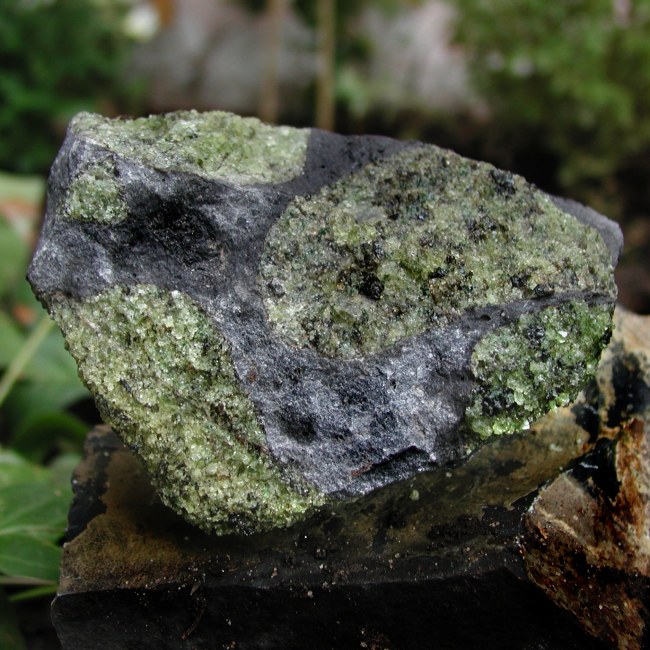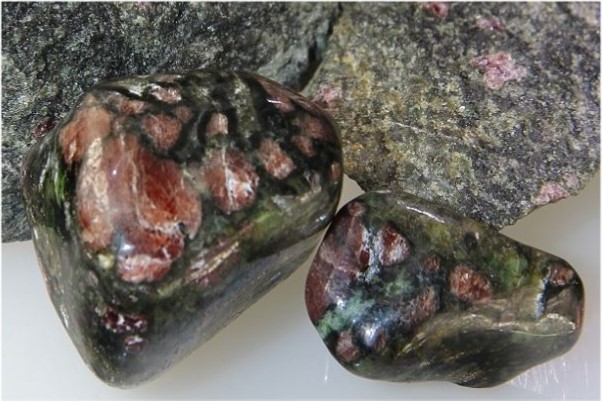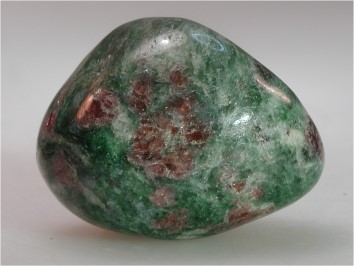The rocks garnet-pyroxenite, garnet-peridotite and eclogite, all with a red-green speckled appearance, look very similar and yet are very different. They can occur side by side at the same locality and are easily confused. In the past they were only interesting for stonemasons, but in the last years they are increasingly offered as tumbled stones and gemrocks.
Garnet-Pyroxenite
Pyroxenites are igneous rocks consisting of more than 50% pyroxene. These rocks form deep within the Earth's interior in the upper mantle and are brought into the upper crust either by rock displacements or by the intrusion of liquid magma into existing rock layers. One of the popular pyroxenite gemrocks are e.g. »Bronzite-Pyroxenite«.
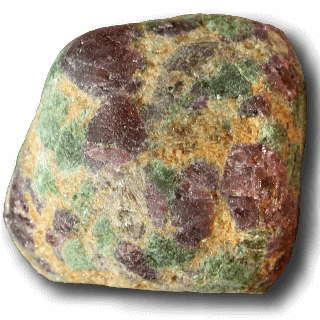
Fig 1: This colorful rock is neither an eclogite nor a garnet peridotite, but a GARNET - PYROXENITE (green: diopside, yellow: enstatite, red: pyrope garnet).
Image: K. Sieber, www.makrogalerie.de
Relatively new among gemrocks is a red - green mottled rock, which according to supplier information originates from the area around Alesund in Western Norway. The EPI laboratory identified the various components by means of X-ray diffraction analysis (RDA). The reddish brown, roundish grains could be identified as pyrope, a mineral from the garnet group. The red color is due to a low iron content of about 1.5%.
In addition, 3 different pyroxene minerals were found:
- dark green diopside
- yellowish green enstatite
- grass green ferrosilite
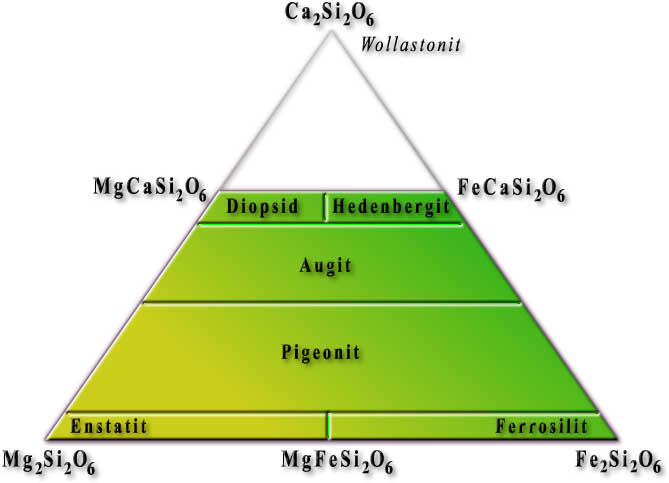
Fig. 2: Chemical composition of Ca-Mg-Fe Pyroxenes
Graphics: © EPI-Institut
The identified pyroxene minerals are closely related and differ mainly in their contents of magnesium (Mg), calcium (Ca) and iron (Fe) (Fig. 2). Based on the composition of garnet and various pyroxene minerals, the studied rock could be characterized as garnet-pyroxenite.
Garnet-Peridotite
Peridotites are one of the most magnesium-rich rocks we know. They are composed mainly of the mineral olivine - in gem quality also called peridot - and various pyroxene minerals.
The fine- to medium-grained, green to brownish green rocks typically consolidate in the Earth's mantle at depths of 50 to 500km. When uplifted into the Earth's crust, they gradually transform into masses of serpentinite.
One of the most recognized peridotite rocks is called Dunite. The name comes from one of its occurrences in the Dun Mountains of New Zealand. Other deposits are in Germany, Italy, Norway and Spain. Dunite aggregates that reach the earth's surface in an already crystallized state during volcanic eruptions are called "volcanic bombs" or "olivine bombs". They are found embedded in basaltic lava.
The largest olivine deposit in the world is located near Åheim, in western Norway. Here in the Gusdalen deposit, about 2 million tons of peridotite are mined per year in open-pit mining. The peridotite body was injected from the upper earth's mantle into gneisses up to 2 billion years old. It is coarse-grained and relatively homogeneous and includes zones of serpentinites and lenses of talc and other minerals. In the contact zone with the gneiss colorful rocks of garnet - pyroxenite and eclogite (see below) have formed.
From Alpe Arami in Ticino, comes a peridotite characterized by high magnesium and chromium contents. It was formed during an early alpine metamorphic phase. Therefore scientists speak of a meta-peridotite (metamorphically overprinted peridotite). An investigation of the formation conditions showed a formation in approx. 120 km depth at nearly 1000° C and over 45 kbar pressure. Thus it represents a fragment of the upper european mantle, which was incorporated into the continental crust. The rock consists of chromium-rich minerals, especially black-green olivine and brown bronzite as well as sometimes intense green chromium diopside and chromium-rich red to redish violet pyrope garnets.
Peridotites are used as decorative stones or as gravestones in the stonemason sector. Well-known varieties are »Solwark« (peridotite from Norway) and »Poschiavo« (serpentinized peridotite from Switzerland).
Separation of (garnet) pyroxenite, (garnet) peridotite and eclogite
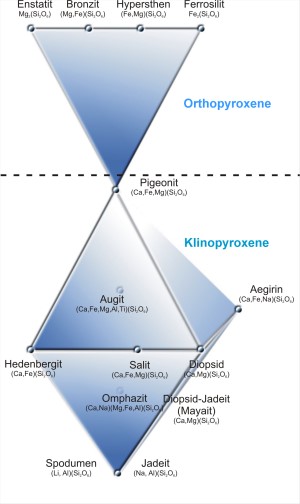
Fig. 5: Group of ortho- and clinopyroxenes
Grafic: © EPI-Institut
Most pyroxenes form crystal shapes with monoclinic symmetry (so-called "clinopyroxenes"). A few, however, have crystal forms with orthorhombic symmetry and are called "orthopyroxenes".
To distinguish between (garnet-) pyroxenites and (garnet-) peridotites, knowledge of the mineral assemblage is required, as well as the quantitative occurrence of individual minerals and the ratio of ortho- and clinopyroxenes. In many cases, such a distinction cannot be mastered without laboratory techniques. However, in the following some clues are listed, which can facilitate an assignment.
Pyroxenite
Main mineral of all pyroxenites are magnesium-rich pyroxene minerals (> 50%). As accompanying minerals olivine (< 40%) can occur. Further accompanying minerals can be garnet, spinel, chromite and magnetite. The demarcation to the peridotites is based on the mineral content. The limit is less than 40% olivine and more than 50% pyroxene.
Peridotite
Main mineral of all peridotitic rocks is olivine (> 60%) As accompanying minerals magnesium-rich orthopyroxenes (enstatite to bronzite), as well as magnesium-rich clinopyroxenes diopside to chrome diopside can occur. Further added can be garnet, spinel, chromite and others. Magnetite can be formed during serpentinization processes.
Eclogite
Eclogites are metamorphically formed high pressure rocks, which consist essentially of 2 minerals.
- red, pyrorich garnet (mostly rhodolite)
- green, sodium containing clinopyroxene (mostly omphacite)
The distinction from similar looking garnet pyroxenites is based on the dominance of sodium-rich clinopyroxenes like omphacite and jadeite. Orthopyroxenes do not occur. Both clinopyroxenes and orthopyroxenes with calcium-magnesium-iron (Ca-Mg-Fe) composition occur in garnet pyroxenites (Fig. 2).
Lit: Torgeir T. Garmo (2013), Olivine und Eklogite aus Åheim, Mineralienwelt, 2, 81-86 (in german language)




